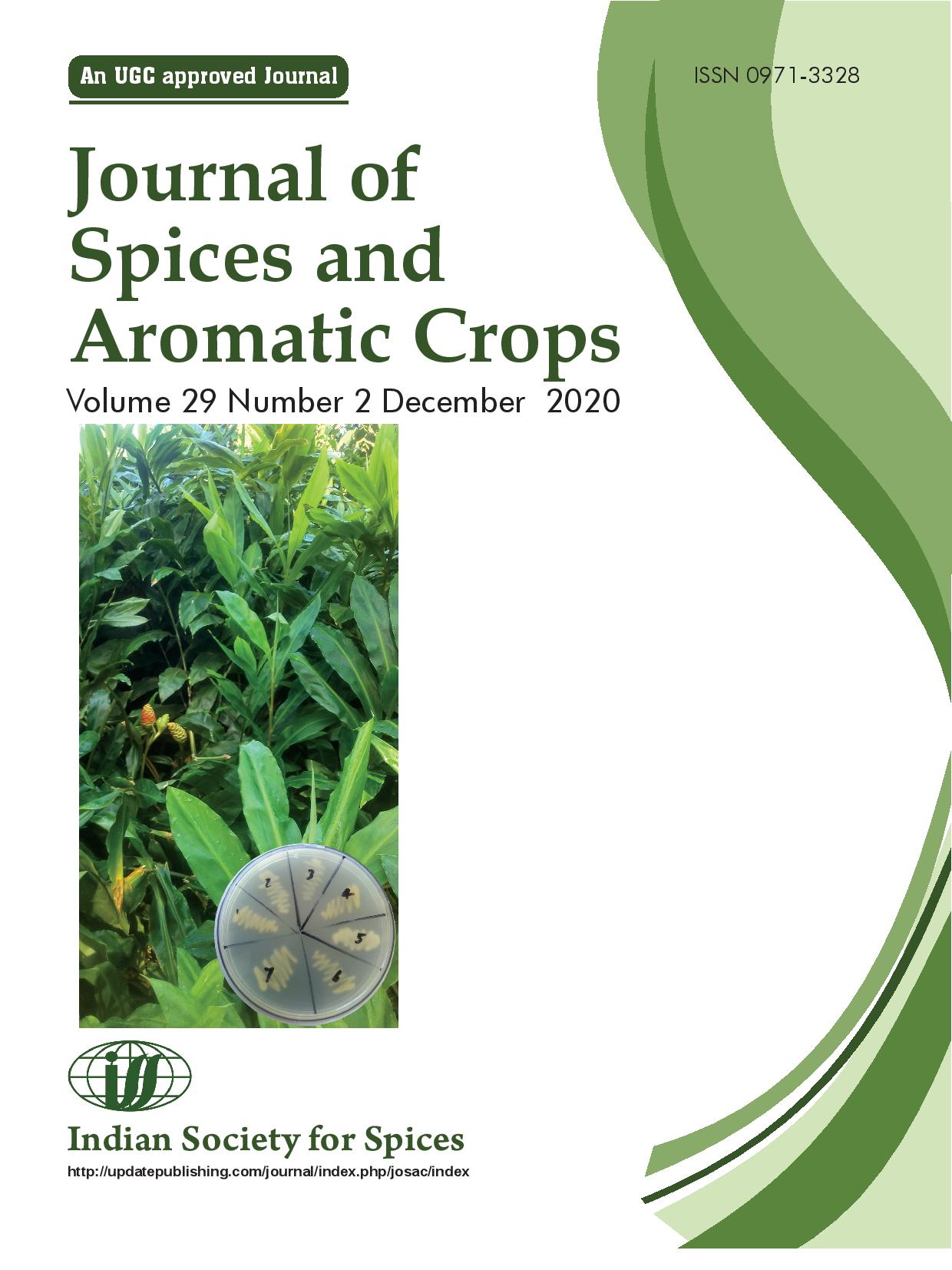Morphological characterization and secondary metabolites profile of black pepper (Piper nigrum L.) genotypes from Sikkim
DOI:
https://doi.org/10.25081/josac.2020.v29.i2.6347Keywords:
black pepper, volatile oil, HPLC, metabolitesAbstract
Quantification of volatile oil and analysis of four major metabolites using HPLC was done in 24 black pepper genotypes collected from south Sikkim. The amount of volatile oil ranged from 2.01% to 0.022%. Secondary metabolites like piperine ranged from 2.75-0.022%, myrcene from 2.094-0.022%, alpha- phellandrene from 1.373-0.008% and linalool from 0.834-0.012%. Genotype 23 had the highest amount of myrcene and linalool, genotype 13 had the highest quantity of piperine and genotype 8 had high amount of alpha-phellandrene. The principal component analysis (PCA) of analyzed metabolites grouped the genotypes into four categories. The study revealed that some of the genotypes were as good as pepper varieties grown in traditional areas. These genotypes will be useful in crop improvement strategies and suitable for Sikkim Himalaya.
Downloads
References
Chauhan R, Dwivedi J & Siddiqui A A 2008 Chemical standardization and quantification of piperine from methanolic extract of Piper nigrum by HPLC method on the basis of isolated markers. Int. J. Chem. Sci. 6: 1726–1733.
Chen Y S 2013 An investigation on possible occurrence of apomixes in pepper (Piper nigrum). In. Proceeding, 2nd International Conference on Environment, agriculture and food sciences (ICEAFS’2013) May 6–7 Kuala Lumpur (Malaysia).
Epstein W W, Netz D F & Seidel J L 1993 Isolation of piperine from black pepper. J. Chem. Ed. 70: 598–599.
Jirovetz L, Buchbauer G, Ngassoum M B & Geissler M 2002 Aroma compound analysis of piper nigrum and piper guineense essential oils from Cameroon using solid phase microextraction-gas chromatography, solid-phase microextraction –gas chromatography-mass spectrometry and olfactometry. J. Chromatogr. A. 976: 265–267.
Krishnamurthy K S, Ankegowda S J, Srinivasan V & Hamza S 2013 Influence of carbohydrates, mineral nutrients and plant hormones in alternate bearing of black pepper (Piper nigrum L.). American J. Plant Sci. 4: 1960–1967.
Prasannakumari S, Nybe E V, Sujatha V S & Prabhakaran P V 2001 Survey, evaluation and identification of black pepper cultivars. J. Trop. Agric. 39: 9–12.
Rmili R, Ramdani M, Ghazi Z, Saidi N & El Mahi B 2014 Composition comparison of essential oils extracted by hydrodistillation and microwave-assisted hydrodistillation from Piper nigrum L. J. Mater. Environ. Sci. 5: 1560–1567.
Sasikumar B, Saji K V & Johnson K George 2007 Spike proliferation in black pepper (Piper nigrumL.). Fruits. 62: 325–328.
Shahin A, Naher S, Abukawsar M D & Roy S K 2012 Comparative studies on physicochemical properties and GC-MS analysis of volatile oil of the two varieties of the black pepper (Piper nigrum Linn.). Int. J. Pharm. Sci. Res. 2: 67–70.
Shruti D, Zachariah T J, Leela N K & Jayarajan K 2013 Correlation between chemical profiles of black pepper (Piper nigrum L.) var. Panniyur -1 collected from different locations. J. Med. Plants Res. 7: 2349–2357.
Singh H, Kumoro A C & Hasan M 2010 Extraction of sarawak black pepper volatile oil using supercritical carbon dioxide. Arabian J. Sci. Eng. 35: 7–16.
Trelease W & Yuncker T G 1950 The Piperaceae of Northern South America, University Illinois, USA.
Vasavirama K & Upenders M 2014 Piperine: A valuable alkaloid From Piper species. Int. J. Pharm. Pharm. Sci. 6: 34–38.






 .
.